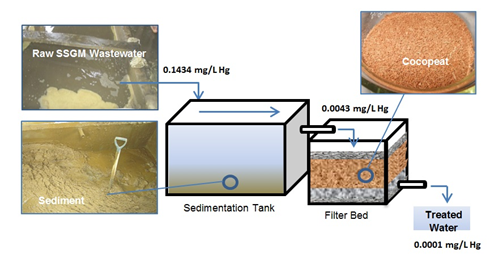Document Type : ORIGINAL RESEARCH ARTICLE
Authors
1 Department of Science and Technology - Philippine Nuclear Research Institute, Commonwealth Ave., Diliman, Quezon City, Philippines
2 Environmental Engineering Graduate Program, College of Engineering, University of the Philippines-Diliman, Quezon City, Philippines.
3 Environmental Engineering Graduate Program, College of Engineering, University of the Philippines-Diliman, Quezon City, Philippines
Abstract
The use of amalgamation process to recover gold from mined ores by the small-scale gold miners in the Philippines and other developing countries produces and dispose of untreated wastewater to the receiving water bodies. In this study, a field-scale filter bed system was constructed to treat heavy metal metal-laden wastewater collected from small-scale gold mining site in Paracale, Camarines Norte, Philippines. The filter bed system was consists of sedimentation tank and filter bed with Cocopeat, a by-product of coconut husk, as adsorbent. Physico-chemical parameters (temperature, pH, oxidation-reduction potential, electrical conductivity, turbidity, dissolved oxygen, total dissolved solids, salinity, total suspended solids, color) and heavy metal (As, Ba, Cd, Hg, Pb) concentrations were monitored during the 50 days experiment at a flow rate of 40 Liter per hour for 3 hours daily wastewater application. Significant reduction was achieved on heavy metals; As (97.11%), Ba (39.75%), Cd (74.24%), Hg (97.02%), Pb (98.82%) from small-scale gold mining (SSGM)wastewater in sedimentation phase and further reductions on As (1.39%), Ba (28.00%), Cd (4.95%), Hg (2.91%), Pb (0.97%) were achieved by adsorption in the Cocopeat filter bed. Measured effluent physico-chemical parameters and heavy metal concentrations were within the respective regulatory limits. Other effluent parameters with strong correlation with total suspended solids such as turbidity and color, though not regulated, were reduced significantly. All adsorbed heavy metals accumulated in the upper 25 cm of the Cocopeat column in the filter bed. Measured heavy metal concentrations in Cocopeat suggest that the adsorbent was not saturated and further application of small-scale gold mining wastewater is recommended to determine its useful life.
Graphical Abstract
Highlights
- Combination of sedimentation tank and Cocopeat filter bed system treated the heavy metals from small scale gold mining wastewater;
- Total suspended solids and turbidity were reduced significantly;
- Adsorbed heavy metals accumulated first in the upper part of the Cocopeat column.
Keywords
Main Subjects



Letters to Editor
[1] Letters that include statements of statistics, facts, research, or theories should include appropriate references, although more than three are discouraged.
[2] Letters that are personal attacks on an author rather than thoughtful criticism of the author’s ideas will not be considered for publication.
[3] Letters can be no more than 300 words in length.
[4] Letter writers should include a statement at the beginning of the letter stating that it is being submitted either for publication or not.
[5] Anonymous letters will not be considered.
[6] Letter writers must include their city and state of residence or work.
[7] Letters will be edited for clarity and length.
Send comment about this article